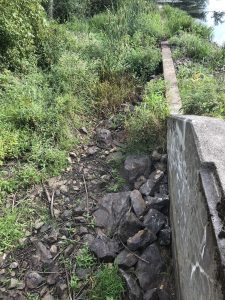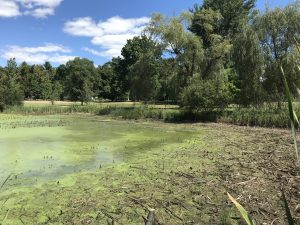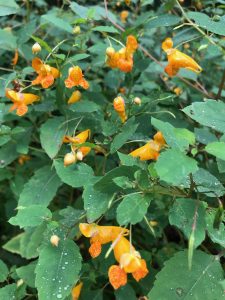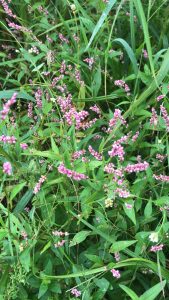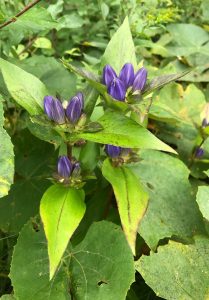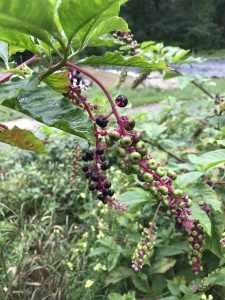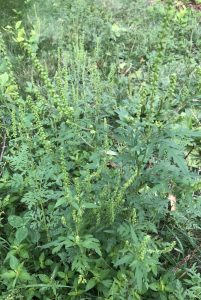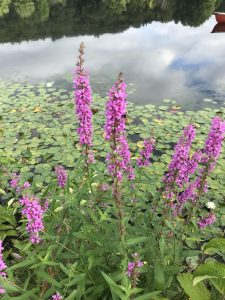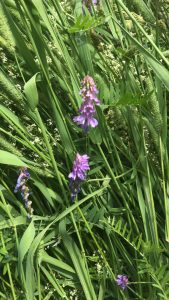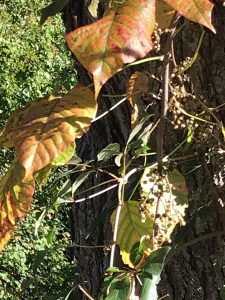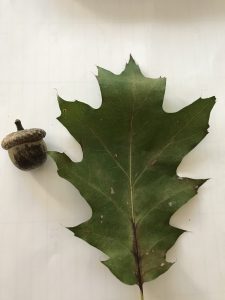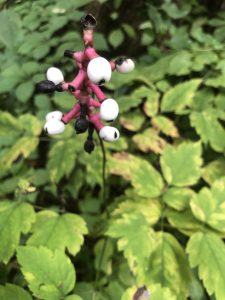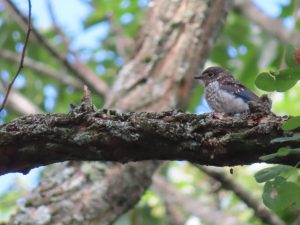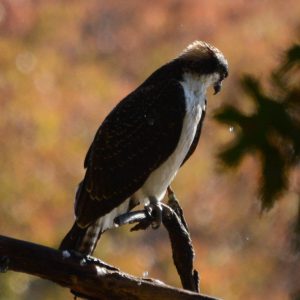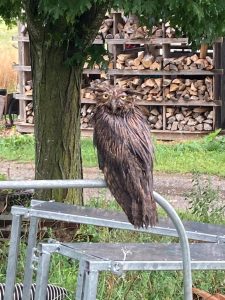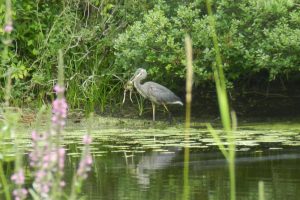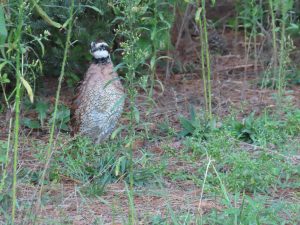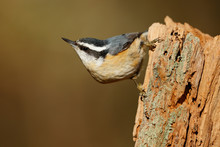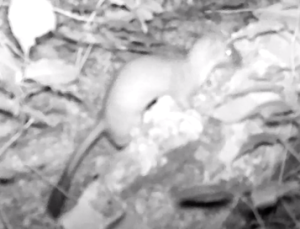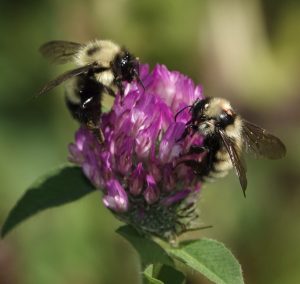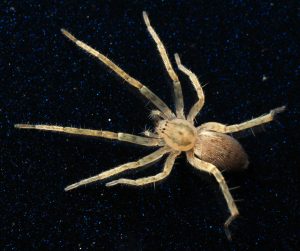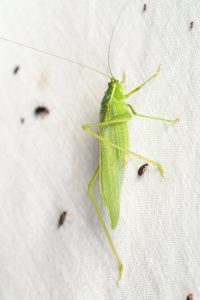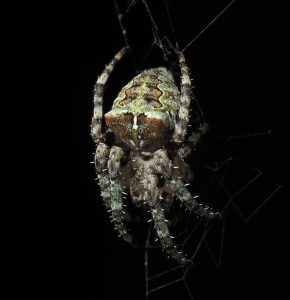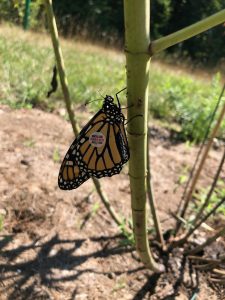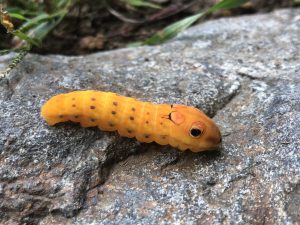Written by Gwyn Loud for the Lincoln Land Conservation Trust. She welcomes your sightings and questions at 781-259-8690 or gwynloud555@gmail.com.
What a difference a year makes: my column for September 2021 described our unusually wet summer! We certainly could have used some of that rain this summer, as we have been in severe or critical drought for several months, in spite of nearly 3 inches of welcome rain on Sept. 5 and 6. Pond levels are low and some stream beds are nearly or totally dry. Various plants, both wild and cultivated, have dried up or failed to flower, fruit, or set seed, with resulting impacts on pollinators and other wildlife looking for food. It is noticeable, however, how even a little shade benefits flora, and clearly some plants have deep enough roots to reach down to find groundwater, or other “strategies” which enable them to survive periodic droughts. Weather extremes seem evermore with us as our planet deals with a changing climate. As stewards of our land we can each do our part to save water and adopt practices to help our local flora and fauna survive the changes. Stay tuned for some fall gardening tips from the LLCT.
On recent meadow walks I was glad to find goldenrod and asters in bloom, as well as some Joe-Pye weed in flower, although most had gone to seed early. Wild carrot, red clover, low smartweed (pink), tufted vetch (purple) and some beautiful closed gentian (blue) provided spots of color. Along a shady lane I was happy to find touch-me-not (aka jewelweed) with its orange cornucopia-shaped flowers, a favorite of hummingbirds. Both common mugwort and ragweed have inconspicuous green blossoms, the latter being the source of allergies for some sufferers. Purple loosestrife is blooming in damp areas, and white or yellow lilies grace the surface of various ponds. So far there are only hints of colorful fall foliage but crisp cool air will change the scene in weeks ahead. Even though red oaks are dropping acorns in good numbers, it does not look like this will be a mast year. Gray dogwood, pokeweed, poison ivy and Virginia creeper are among many shrubs and vines which produce berries which serve as fall and winter food for birds and other fauna.
Among the birds breeding in Lincoln this summer was a pair of red-shouldered hawks in my neighborhood with noisy begging young. Eastern bluebirds raised many successful broods in the boxes at Drumlin Farm and in many backyards. Green herons were spotted in several places, including one in the Pierce Park Pond and four juveniles by Valley Pond. Young barn swallows gathered as usual ( although fewer than in the past) on the wires bordering Browning Field and I suspect some came from nests in a huge barn not far away.
The fall bird migration began weeks ago without fanfare as various birds quietly left for points south; suddenly we realized that the orioles, swallows, and rose-breasted grosbeaks, for example, were no longer around. Recently, a few common nighthawks were seen passing through, swooping low to catch insects on the wing. Soon we will be aware of geese honking in skeins overhead and noisy flocks of grackles and blackbirds. September is hawk migration month and broad-winged hawks are often seen in great “kettles” riding the winds, the thermals, to help them on their journey. Some hawks, such as red-winged hawks, Cooper’s hawks, and sharp-shinned hawks stay here year-round. Many wood warblers, so colorful in spring breeding plumage, have molted to duller garb and thus are often called “CFWs” (confusing fall warblers) by birders, as identification can be tricky. A few warblers nest here but most nest farther north and pass through on migration. Ruby-throated hummingbirds, favorite summer residents, will depart in the next week or two; the males have already gone. Various species of sparrows will soon be passing through; already the chipping sparrows are here in flocks.
Notable recent avian reports from Drumlin Farm include an orchard oriole, American redstart, solitary sandpiper, and a dickcissel. Osprey have been spotted regularly over Farrar Pond. Observers from several parts of Town have seen unusual numbers of red-breasted nuthatches, perhaps indicating that this winter will be one in which we see additional “irruptive” species coming down from Canada to seek food. A very water-logged great-horned owl was found in one of the barns at Codman Farms. It was a big surprise to hear about a pair of bobwhite (aka quail), quite tame, and feasting on seeds on the ground by a house on Conant Rd. It has been decades since this species has been seen or heard in Lincoln. Are they wild or perhaps escapees from someone raising quail? As in the past, volunteer Patti Cable monitored bird boxes on LLCT properties. To read about how the nests fared this summer, please read the attachment linked below, which includes excellent photographs!
Mammal sightings over the last month include river otters, one at the Ice Pond at Drumlin Farm and a family of young captured in trail cam footage, running along Valley Brook, which runs under Conant Rd. into Valley Pond. The same camera picked up beaver, bucks, a doe with fawn, and a short-tailed weasel. A bobcat was seen again in that area, which is connected to the large Rando Swamp, impenetrable except to wildlife. A Winter St. resident wrote about raccoons making nightly visits to a grape arbor, eating the grapes even before they were ripe. A few people reported seeing bats overhead at dusk, and no doubt we have all watched plenty of chipmunks dashing over lawns and along stonewalls.
The insect chorus of katydids, crickets, grasshoppers, and cicadas has performed as expected in the hot weather and well into the evening. The decline of insects in general is worrisome and Norman Levey, who has photographed numerous bumblebees, wrote, “I am alarmed at the decline of the bumblebee populations in areas of town hard hit by drought- no flowers.” Luckily, goldenrod, a magnet for bees, is blooming now. Norman has also photographed spiders this summer, opening our eyes to small but common animals we often overlook.
Monarch butterflies are starting their long migration to Mexico, making the journey by instinct since these individuals have never done it before. My neighbor, Carol Roede, raised four monarchs from caterpillars she found on her milkweed and then tagged them with uniquely-numbered tags before releasing them. The Monarch Watch tagging program, which has been running for thirty years from the U. of Kansas, collects data to better understand monarch populations.
Fish are animals I rarely mention but the Mass Division of Fisheries and Wildlife recently posted information about how drought has an especially detrimental effect on stream fish. As the water decreases, its quality also diminishes as it heats up faster and loses dissolved oxygen, making it hard for the fish to survive. Predators can also more easily catch fish in small shallow pools. “Currently, MassWildlife is collaborating with USGS to study changing streamflow patterns and warming temperatures in streams across the state. The goal of this project is to identify areas, called climate change refugia, that are least likely to change in the coming decades.”
On Sept. 22, the autumnal equinox, fall will officially arrive, On this day the sun shines directly on the equator, and the northern and southern hemispheres get the same amount of rays.
Relevant links
Carol Roede’s Trail Cam Footage (Otters)
Carol Roede’s Trail Cam Footage (Weasel)
To read more about the status of the drought in MA
To read more about how the drought affects fish


